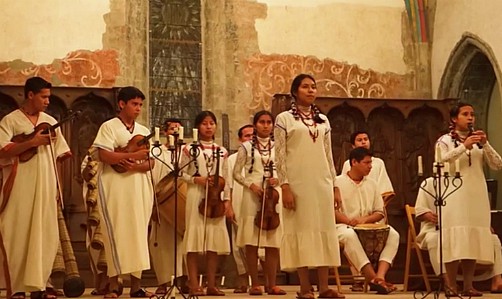|
Jesuit Missions Baroque Music The English word baroque music is derived from the Italian barocco, meaning bizarre. The usage of this term originated in the 1860s to describe the highly decorated style of 17th and 18th century religious and public buildings in Italy, Germany and Austria. Later, during the early-to-mid 1900s, the term was applied by association to music of the 17th and early 18th century, and today the term... has come to refer to a very clearly definable type or genre of music which originated, broadly speaking, around 1600 and came to fruition between 1700 and 1750. (Visit www.baroquemusic.org, the most complete resource available online. You can listen to samples from many famous composers like Bach and Tortelli).
Bolivian Baroque Music in the Amazon
Famous for their music, Jesuit missionaries from Spain and Italy arrived in South America almost 400 years ago. Versed in the fine arts of Europe, they brought with them the classical baroque music and established missions across central South America, in areas that are part of modern-day Paraguay, Argentina, Bolivia and Brazil. These missions, known as reducciones, became home and refuge to thousands of Paraguay's Guarani Indians. The missionaries not only provided shelter but also taught the Guarani people to play European music and make their own instruments, including the cello, harp and violin. Each mission had a church, an orchestra, several artisans' shops, and schools of music and painting. https://youtu.be/4UXaAqCIUng After the Spanish expelled the Jesuits in 1767, the baroque-style compositions all but disappeared. But in the 1970s, while restoring an old mission church in Bolivia, Hans Roth, a Jesuit architect from Switzerland, found 5,000 pages of original sheet music buried in the ruins. The find included music written by 17th- and 18th- century indigenous and European composers, including Zipoli. Roth dedicated his life to the renovation of mission churches in Bolivia's Chiquitos Province, better known as the Chiquitania, and in 1990, UNESCO designated six of them as World Heritage Sites. https://youtu.be/otGyaLpiWoo A cache of manuscripts that had lain forgotten for 300 years was behind one of classical music’s most unlikely pairings: two musicians from opposite sides of the world and from utterly different cultures. Henry Villca grew up in a poor village in Bolivia and earned a living singing in a Mexican folk band. Ashley Solomon studied at the Royal Academy of Music and is a leading exponent of Baroque music as artistic director of the ensemble Florilegium. The archives of Bolivian Baroque music, composed by European Jesuits and by indigenous people, were discovered by Piotr Nawot, a Polish priest who was director of the La Paz choir in which Villca sang. The manuscripts had been hidden away for centuries in mission churches. Some of the pieces have text in native
Bolivian languages.
https://youtu.be/SZ3fYp_jHlc When he heard Solomon’s ensemble, Florilegium, Nawot decided they would be the perfect interpreters of the music and approached them. He offered Solomon first refusal on a vast archive of unknown music from the period. “I said yes, and Piotr sent me 30kg of manuscripts in the post,” Solomon says. This led Solomon to organise fundraising concerts in the UK for Bolivian children. The concerts were so popular that he decided to record a CD of some of the rediscovered music and to use Bolivian singers to bring out its particular characteristics. https://youtu.be/_aOg-1ACnBA Bolivian Baroque music has a natural allure. It is joyous music, and the scores are structured in a clear and symmetrical way. Chiquitos and Moxos belonged to the Jesuit missions in the east of Bolivia, where this music was developed throughout the 18th century. Following the forced departure of the Jesuits in 1767, the population carefully preserved the scores and continued to compose Baroque music and to produce stringed instruments. The Chiquitos and Moxos archive contains ten thousand pages of original scores dating from this period. Since the 1990s, APAC has been actively collecting and interpreting this musical heritage, and supports the setting up of youth orchestras and choirs in this area. In addition, it has been organising a biennial (on even years) Festival of Baroque Music in Santa Cruz and the former mission areas of Chiquitos, Moxos and Guarayos since 1996. The performances are the result of a collaboration between the Asociación Pro Arte y Cultura (APAC) of Santa Cruz (Bolivia), the Prince Claus Fund and the DOEN Foundation. The 1986 Academy Award-winning, British film The Mission (starring Robert de Niro, Jeremy Irons, Liam Neeson, Aidan Quinn) tells the story of the Jesuit missionaries, the missions they established, and the vital part they played in bringing baroque music to the Guarani Indians in South America. Italian composer Ennio Morricone created the musical score. https://youtu.be/lAoT2ktM2H0 Today you can visit the centuries-old Jesuit Missions of the Chiquitania in Bolivia. You can also plan to attend the Latin American Baroque Music Festival which takes place very two years. Contact Ruta Verde Bolivia for tours. Music of Eastern Bolivia and Amazon TropicsMusic of Bolivia's Central and Southern ValleysAndean Music of Bolivia’s Western Mountains    |
